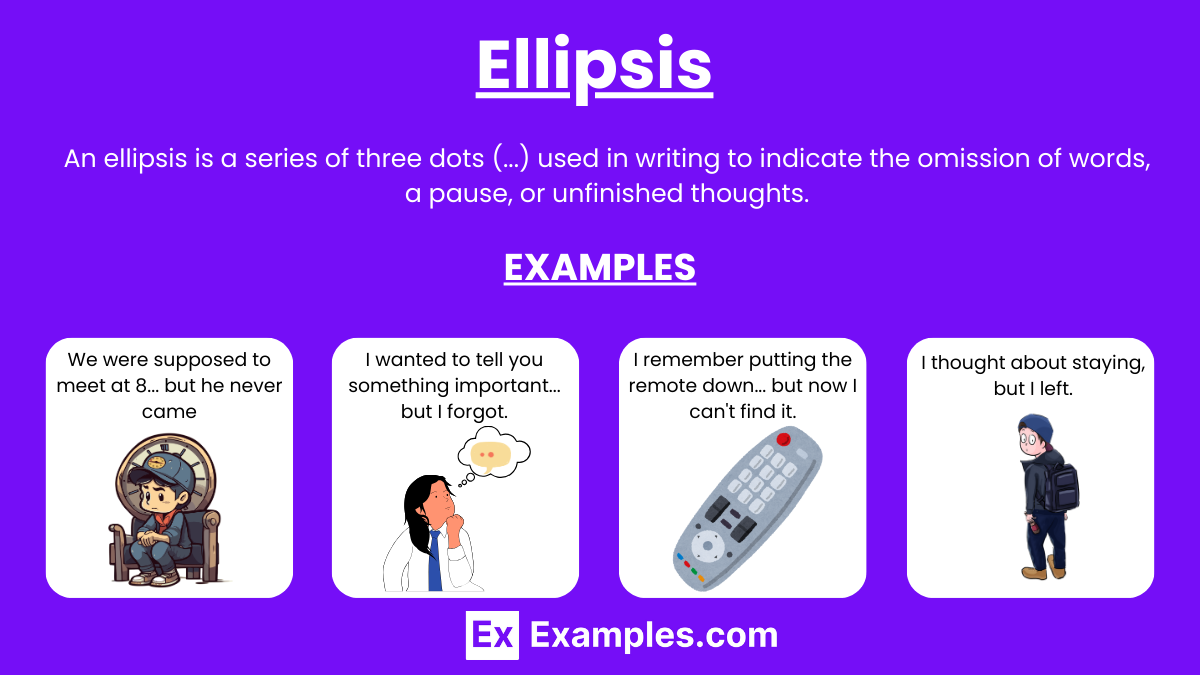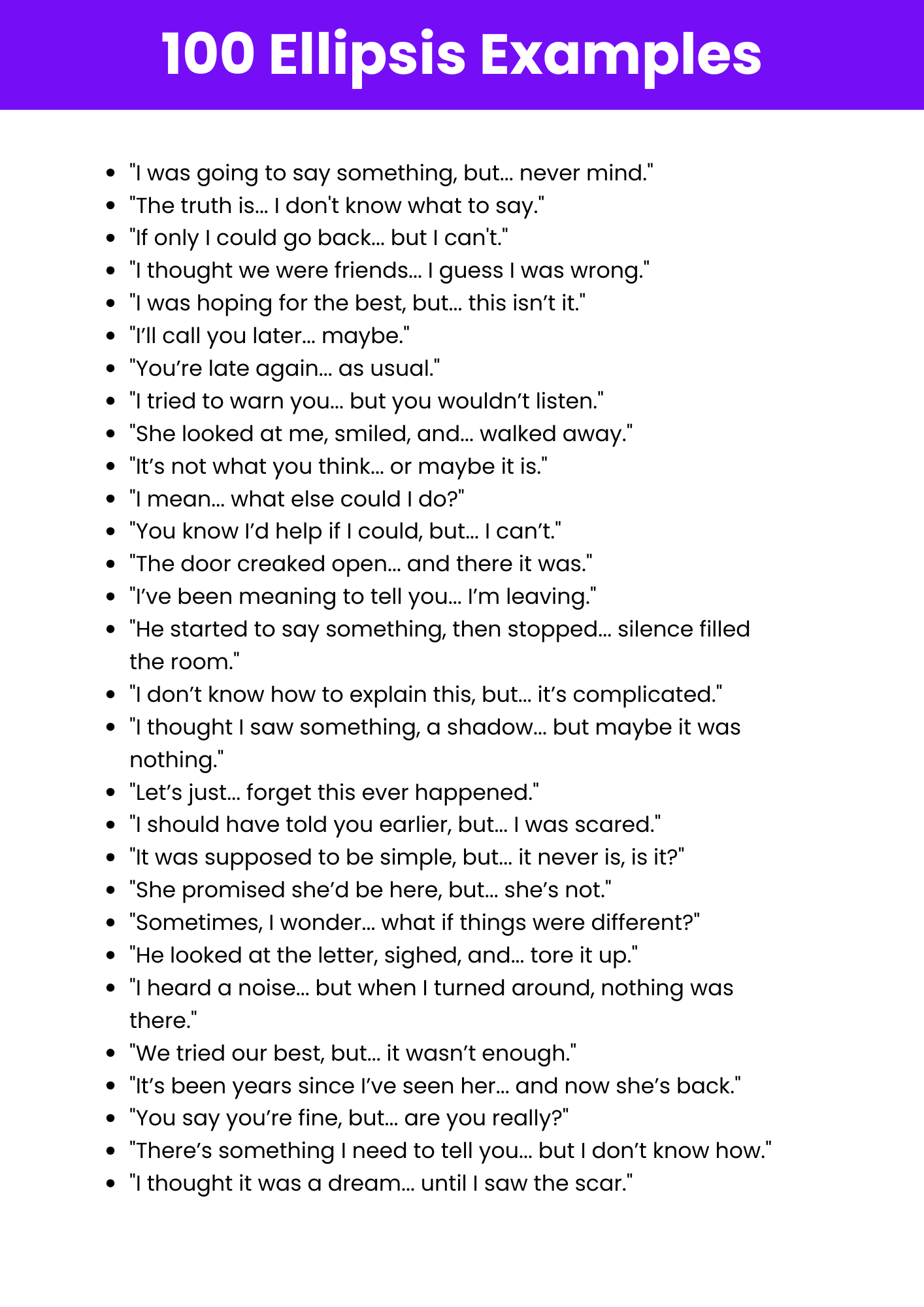Ellipsis
What is Ellipsis? – Definition
An ellipsis is a punctuation mark consisting of three dots (…) used to indicate an omission, a pause, or a trailing off in thought. It’s not meant to be read literally but helps to create a specific effect or convey a particular tone.

Generated Ellipsis Examples

Download Ellipsis Examples
Enhance your understanding with our comprehensive PDF guide.
Download PDFExamples of Ellipses
- I couldn’t believe it, and then…
- She wanted to speak, but…
- The lights flickered, and suddenly…
- He turned to leave, but then…
- The moment felt urgent, and then…
- She was watching closely when…
- I heard a noise, and then…
- He realized his mistake, but…
- The event was about to start when…
- I wanted to help, but…
- They were waiting for someone, but…
- He was deep in thought when…
- The doctor arrived just in time, but…
- The clouds parted, revealing…
- The group hesitated before deciding…
- The dog barked and then…
- He smiled and said…
- The fire crackled softly as…
- Time seemed to slow as…
- The work was unfinished, but…
- She was reading the story when…
- The movie reached its climax, and then…
- The peaceful moment was interrupted when…
- She gave her approval, but then…
- The notification came, and then…
- The game was tied when suddenly…
- She was at the checkout counter, and then…
- The celebration was about to begin when…
- The explorer ventured deeper into the cave and…
- She was cleaning the house when…
Types of Ellipsis
Nominal Ellipsis
Omits a noun in a noun phrase, with the remaining context making the meaning clear.
- Some prefer apples, but I prefer [bananas].
- I have three books; she has two [books].
- This dress is red, and that one [dress] is blue.
- I’ll take the chocolate cookies, not the vanilla [cookies].
- Some enjoy parties; others [people] prefer solitude.
Verbal Ellipsis
Omits a verb or part of a verb phrase when the meaning is clear from the context.
- She can sing, and he can [sing] too.
- I will go if you [go].
- They might have left earlier than we [left].
- He was playing chess, and she [was playing] cards.
- You should work harder than you currently [work].
Clausal Ellipsis
Omits part or all of a clause while relying on the remaining text to convey the meaning.
- I love pizza, but not [I love] burgers.
- She said she would come, but she didn’t [come].
- If you need help, let me know; if not [if you don’t need help], I’ll leave.
- He wanted to visit Paris, and she [wanted to visit] London.
- Do you prefer tea or [do you prefer] coffee?
Gapping
Omits repeated words in coordinated clauses, often leaving gaps that are filled by context.
- John ordered pizza, and Mary [ordered] pasta.
- Peter likes tennis; Susan [likes] basketball.
- I bought apples; you [bought] oranges.
- He plays guitar, and she [plays] violin.
- I went to the market, and Sarah [went] to the park.
Situational Ellipsis
Omits words commonly understood in a given situation or context.
- (At a restaurant) “One coffee, please.” [I would like one coffee.]
- (During a roll call) “Present.” [I am present.]
- (In a conversation) “Ready to leave?” [Are you ready to leave?]
- (At a cashier) “Card or cash?” [Will you pay with a card or cash?]
- (On a phone call) “Speaking.” [This is the person speaking.]
How to Identify/Find Ellipsis?
To identify ellipsis, look for missing parts of a sentence where the meaning is still clear from the context. Ellipsis often simplifies communication or creates dramatic pauses for emphasis.
- Look for sentences with missing elements but a clear meaning.
- Identify pauses or omissions that imply additional words or ideas.
- Check if the omission avoids redundancy in repeated ideas.
- Notice pauses that create suspense or emotional emphasis.
- Look for ellipsis that enhances conversational flow or dramatic effect.
How to Use Ellipsis?
Use ellipsis to create natural pauses, emphasize key points, or avoid unnecessary repetition. Ensure your ellipsis fits the context and enhances clarity or dramatic effect without causing confusion.
- Use ellipsis to omit redundant parts of a sentence.
- Add pauses to build suspense or focus on key ideas.
- Use ellipsis sparingly to maintain its effectiveness.
- Ensure the missing elements are implied and understandable.
- Integrate ellipsis naturally to enhance readability and tone.
Other Ellipsis Examples
Ellipsis in Daily Life
Ellipsis often appears in everyday conversations and informal contexts to make communication concise.
- “Want coffee?” instead of “Do you want coffee?”
- “Going out?” instead of “Are you going out?”
- “Need help?” instead of “Do you need help?”
- “Coming with us?” instead of “Are you coming with us?”
- “Any questions?” instead of “Do you have any questions?”
Ellipsis in Poetry
Ellipsis in poetry is used to create rhythm, mystery, or leave parts of the imagery open to interpretation.
- “I wandered lonely as a cloud… among the hills and valleys.”
- “Through the woods… silence lingered.”
- “The stars were shining… above the misty mountains.”
- “Love lost… in the whisper of the wind.”
- “The dawn… breaking the night.”
Ellipsis in Real Life
Ellipsis naturally occurs in spoken language to save time and simplify communication.
- “Want a ride?” instead of “Do you want a ride?”
- “Got it?” instead of “Did you get it?”
- “Heading out?” instead of “Are you heading out?”
- “Dinner at 7?” instead of “Is dinner at 7?”
- “See you later?” instead of “Will I see you later?”
Ellipsis in Literature
Authors use ellipsis to create dramatic pauses or leave certain ideas for the reader’s interpretation.
- “To be, or not to be… that is the question.”
- “It was the best of times… it was the worst of times.”
- “She was gone… vanished into the night.”
- “The truth is… I never cared.”
- “And then… silence.”
Ellipsis in Movies
Ellipsis in movies often occurs through dialogue, allowing for natural pacing and emphasis.
- “I’ll be back…” – Terminator
- “Frankly, my dear… I don’t give a damn.” – Gone with the Wind
- “With great power… comes great responsibility.” – Spider-Man
- “May the Force be with you… always.” – Star Wars
- “To infinity… and beyond!” – Toy Story
Explore Other Literary Devices
Elevate Your AP English Preparation
Unlock your potential with our comprehensive AP English exam preparation tools designed to help you excel.
- Extensive Question Bank: Access 900+ exam-like questions for both AP English Language and Literature.
- Expertly Crafted: Questions mirror the structure and difficulty of actual AP exams, ensuring relevant practice.
- Detailed Explanations: Understand your mistakes with clear, concise breakdowns of correct and incorrect answers.
- Personalized Learning: Tailor your study sessions with topic-specific tests and adaptive learning tools.
- Comprehensive Coverage: Master all aspects of the AP English curriculum with extensive guides and resources.
Frequently Asked Questions
-
What is an ellipsis?
An ellipsis is a punctuation mark consisting of three dots (…) used to indicate an omission of words, a pause, or an unfinished thought. -
When should I use an ellipsis?
Ellipsis are used in writing to show omissions in quotes, create pauses for dramatic effect, or indicate that a thought or sentence trails off. -
What are the rules for using ellipsis?
When using ellipsis, ensure they consist of three dots (…). Use them to omit parts of a quote without altering its meaning or to add stylistic pauses in your writing. -
Can an ellipsis be used at the beginning or end of a sentence?
Yes, ellipses can be used at the beginning or end of a sentence to indicate a pause, hesitation, or omission, but ensure the context makes their use clear. -
What is the difference between ellipses and a dash?
Ellipses indicate omission or trailing off, while a dash (—) is used to emphasize a sudden break or interruption in a sentence. -
Are ellipses acceptable in formal writing?
Ellipses are acceptable in formal writing for omissions in quotes. However, their use for pauses or unfinished thoughts is typically more common in informal writing. -
Can ellipses change the meaning of a sentence?
Yes, if used improperly, ellipses can alter the intended meaning of a sentence, especially in quotes, so their use should be careful and contextually appropriate. -
How do ellipses function in dialogue?
In dialogue, ellipses indicate hesitation, trailing off, or an emotional pause, helping convey a character’s tone or state of mind. -
Can ellipses be overused?
Yes, overusing ellipses can make writing appear disjointed or overly casual. Use them sparingly and only when necessary for clarity or stylistic effect. -
Do different languages use ellipses differently?
Yes, while ellipses are commonly used across languages, their placement, spacing, and frequency may vary depending on cultural and grammatical conventions.

